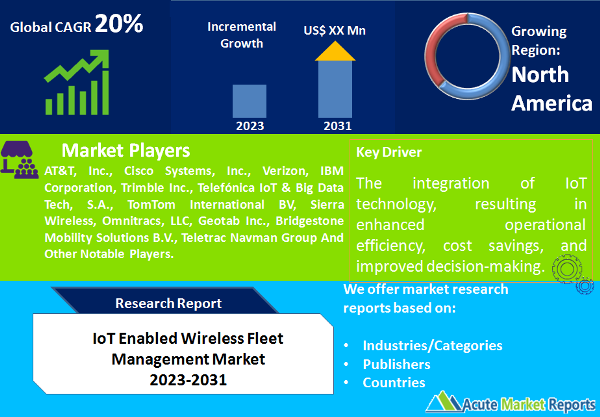
The IoT enabled wireless fleet management market is poised for remarkable growth, projected to achieve a substantial CAGR of 20% during the forecast period of 2025 to 2033. This expansion is attributed to a confluence of factors that have fundamentally reshaped the landscape of fleet management. As of 2025, the market has already witnessed substantial advancements driven by the integration of IoT technology, resulting in enhanced operational efficiency, cost savings, and improved decision-making. The IoT Enabled Wireless Fleet Management Market is set on a trajectory of transformative growth, driven by advancements in IoT technology, operational efficiency imperatives, and safety and compliance demands. While initial implementation costs pose a restraint, the myriad benefits of IoT-enabled fleet management systems are propelling their adoption across industries. As the market evolves toward 2033, the focus on optimizing fleet operations, reducing costs, and ensuring regulatory compliance will remain paramount. The synergy between IoT technology and fleet management is poised to redefine industry norms, ushering in an era of unprecedented efficiency, safety, and sustainable practices.

Advancements in IoT Technology
The integration of IoT technology has emerged as a pivotal driver, revolutionizing the fleet management landscape. Real-time connectivity between vehicles, sensors, and centralized systems enables comprehensive monitoring and analysis of fleet operations. This facilitates real-time data-driven decision-making, optimizing routes, predicting maintenance needs, and enhancing overall fleet efficiency. For instance, Telematics solutions leveraging IoT enablement provide precise vehicle tracking, fuel consumption monitoring, and driver behavior analysis, leading to significant operational enhancements and cost reductions.
Operational Cost Optimization
The adoption of IoT-enabled wireless fleet management solutions is driven by the potential for substantial cost savings. By harnessing data-driven insights, fleet managers can identify inefficiencies, monitor fuel consumption, and optimize route planning. These measures not only reduce fuel expenses but also extend vehicle lifecycles through proactive maintenance scheduling. This cost-conscious approach resonates across industries, from logistics to transportation, driving the widespread adoption of IoT-enabled fleet management systems.
Safety and Compliance Imperatives
Safety remains a paramount concern for fleet operators. IoT-enabled wireless fleet management systems offer advanced safety features such as real-time driver monitoring, collision avoidance systems, and predictive maintenance alerts. These features not only mitigate the risk of accidents but also contribute to regulatory compliance by ensuring adherence to driving hours and vehicle maintenance standards. As safety regulations become more stringent, industries are increasingly turning to IoT-enabled solutions to uphold compliance and safeguard their operations.
Initial Implementation Costs
While the benefits of IoT-enabled wireless fleet management systems are compelling, the initial implementation costs present a notable restraint. The integration of IoT sensors, telematics devices, and communication infrastructure requires a significant upfront investment. Small and medium-sized enterprises (SMEs) may find these costs prohibitive, particularly in industries characterized by thin profit margins. Despite the potential for long-term savings, the initial financial hurdle can hinder widespread adoption, particularly among cost-sensitive segments.
Component: Solution Segment Dominates the Market
The IoT Enabled Wireless Fleet Management market is segmented into solutions and services. IoT-based solutions encompass a comprehensive suite of tools including real-time tracking, predictive maintenance, driver behavior analysis, and more. The services segment encompasses professional services, including implementation, training, and consulting, as well as managed services offering ongoing support and system optimization. In 2024, the solutions segment dominated the market in terms of both revenue and CAGR, driven by increasing demand for advanced fleet management capabilities.
Fleet Type: Commercial Fleets Dominate the Market
The market is further segmented by fleet type, including commercial fleets and passenger fleets. Commercial fleets benefit from IoT-enabled wireless fleet management by optimizing route planning, monitoring vehicle health, and enhancing logistics efficiency. Passenger fleets, including taxis and ride-sharing vehicles, leverage IoT technology to enhance passenger experience, ensure punctuality, and improve overall operational efficiency. In 2024, commercial fleets generated the highest revenue, while passenger fleets exhibited the highest CAGR, driven by the surge in ride-sharing and mobility services.
North America Remains as the Global Leader
Geographically, North America dominated the IoT Enabled Wireless Fleet Management market in 2024, driven by advanced technological adoption and robust logistics and transportation sectors. However, the Asia-Pacific region is expected to exhibit the highest CAGR during the forecast period of 2025 to 2033, owing to rapid industrialization, urbanization, and the increasing need for efficient fleet management solutions. The region is poised to witness extensive adoption, particularly in emerging economies such as China and India.
Market Competition to Intensify during the Forecast Period
The IoT Enabled Wireless Fleet Management market features a competitive landscape shaped by industry leaders such as AT&T, Inc., Cisco Systems, Inc., Verizon, IBM Corporation, Trimble Inc., Telefónica IoT & Big Data Tech, S.A., TomTom International BV, Sierra Wireless, Omnitracs, LLC, Geotab Inc., Bridgestone Mobility Solutions B.V., and Teletrac Navman Group and others. These players are expected to maintain their dominance through strategic partnerships, continuous innovation, and customer-centric solutions. Key strategies include expanding product portfolios, enhancing IoT integration capabilities, and providing value-added services. As the market progresses toward 2033, collaboration between technology providers and fleet operators is expected to intensify, leading to tailored solutions that address industry-specific challenges.
Historical & Forecast Period
This study report represents analysis of each segment from 2023 to 2033 considering 2024 as the base year. Compounded Annual Growth Rate (CAGR) for each of the respective segments estimated for the forecast period of 2025 to 2033.
The current report comprises of quantitative market estimations for each micro market for every geographical region and qualitative market analysis such as micro and macro environment analysis, market trends, competitive intelligence, segment analysis, porters five force model, top winning strategies, top investment markets, emerging trends and technological analysis, case studies, strategic conclusions and recommendations and other key market insights.
Research Methodology
The complete research study was conducted in three phases, namely: secondary research, primary research, and expert panel review. key data point that enables the estimation of IoT Enabled Wireless Fleet Management market are as follows:
Market forecast was performed through proprietary software that analyzes various qualitative and quantitative factors. Growth rate and CAGR were estimated through intensive secondary and primary research. Data triangulation across various data points provides accuracy across various analyzed market segments in the report. Application of both top down and bottom-up approach for validation of market estimation assures logical, methodical and mathematical consistency of the quantitative data.
| ATTRIBUTE | DETAILS |
|---|---|
| Research Period | 2023-2033 |
| Base Year | 2024 |
| Forecast Period | 2025-2033 |
| Historical Year | 2023 |
| Unit | USD Million |
| Segmentation | |
Component
| |
Deployment Type
| |
Application
| |
Fleet Type
| |
|
Region Segment (2023-2033; US$ Million)
|
Key questions answered in this report